
Geranium is a genus of 422 species of annual, biennial, and perennial plants that are commonly known as geraniums or cranesbills. They are found throughout the temperate regions of the world and the mountains of the tropics, but mostly in the eastern part of the Mediterranean region.

Dahlia is a genus of bushy, tuberous, herbaceous perennial plants native to Mexico and Central America. A member of the Compositae family of dicotyledonous plants, its garden relatives thus include the sunflower, daisy, chrysanthemum, and zinnia. There are 42 species of dahlia, with hybrids commonly grown as garden plants. Flower forms are variable, with one head per stem; these can be as small as 5 cm (2 in) diameter or up to 30 cm (1 ft). This great variety results from dahlias being octoploids—that is, they have eight sets of homologous chromosomes, whereas most plants have only two. In addition, dahlias also contain many transposons—genetic pieces that move from place to place upon an allele—which contributes to their manifesting such great diversity.
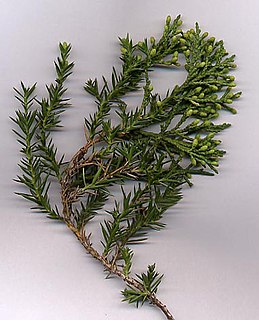
Juniperus chinensis, the Chinese juniper is a species of plant in the cypress family Cupressaceae, native to China, Taiwan, Myanmar, Japan, Korea and the Russian Far East. Growing 1–20 m (3.3–65.6 ft) tall, it is a very variable coniferous evergreen tree or shrub,

Berberis, commonly known as barberry, is a large genus of deciduous and evergreen shrubs from 1–5 m (3.3–16.4 ft) tall, found throughout temperate and subtropical regions of the world. Species diversity is greatest in South America and Asia; Europe, Africa and North America have native species as well. The best-known Berberis species is the European barberry, Berberis vulgaris, which is common in Europe, North Africa, the Middle East, and central Asia, and has been widely introduced in North America. Many of the species have spines on the shoots and all along the margins of the leaves.

Prunus cerasifera is a species of plum known by the common names cherry plum and myrobalan plum. It is native to Southeast Europe and Western Asia, and is naturalised in the British Isles and scattered locations in North America. Also naturalized in parts of SE Australia where it is considered to be a mildly invasive weed of bushland near urban centers.

Hosta is a genus of plants commonly known as hostas, plantain lilies and occasionally by the Japanese name gibōshi. Hostas are widely cultivated as shade-tolerant foliage plants. The genus is currently placed in the family Asparagaceae, subfamily Agavoideae, and is native to northeast Asia. Like many "lilioid monocots", the genus was once classified in the Liliaceae. The genus was named by Austrian botanist Leopold Trattinnick in 1812, in honor of the Austrian botanist Nicholas Thomas Host. In 1817, the generic name Funkia was used by German botanist Kurt Sprengel in honor of Heinrich Funk, a collector of ferns and alpines; this was later used as a common name and can be found in some older literature.

Camellia japonica, known as common camellia, Japanese camellia, or tsubaki in Japanese, is one of the best known species of the genus Camellia. Sometimes called the rose of winter, it belongs to the family Theaceae. It is the official state flower of the US state of Alabama. There are thousands of cultivars of C. japonica in cultivation, with many colors and forms of flowers. In the U.S. it is sometimes called japonica, a name more often used in the UK for Chaenomeles.
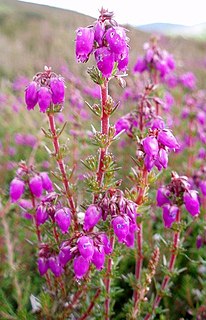
Erica cinerea, the bell heather, is a species of flowering plant in the heath family Ericaceae, native to western and central Europe.
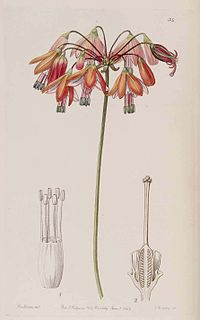
Bessera is a genus of Mexican plants in the cluster lily subfamily within the asparagus family. It is a small genus of 3 known species of mostly herbaceous flowering plants with corms. They have flowers with petals and petaloid sepals (tepals) with compound pistils.

Cosmos bipinnatus, commonly called the garden cosmos or Mexican aster, is a medium-sized flowering herbaceous plant in the daisy family Asteraceae, native to the Americas. The species and its varieties and cultivars are popular as ornamental plants in temperate climate gardens.
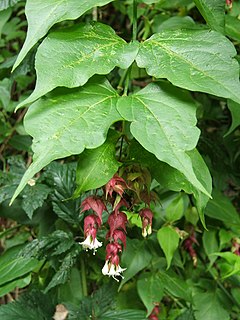
Leycesteria formosa, the Himalayan honeysuckle, flowering nutmeg, Himalaya nutmeg, granny's curls or pheasant berry, is a deciduous shrub in the family Caprifoliaceae, native to the Himalaya and southwestern China. It is considered a noxious invasive species in Australia, New Zealand, the neighbouring islands of Micronesia, and some other places.

Hunnemannia is a monotypic genus of flowering plants in the poppy family Papaveraceae, containing the single species Hunnemannia fumariifolia native to the highlands of Mexico. It is typically found at elevations of 1,500–2,000 m (4,921–6,562 ft) in the Chihuahuan Desert and south into central Mexico, where it favors rocky habitats, occurring along roadsides as well.

Echeveria elegans, the Mexican snow ball, Mexican gem or white Mexican rose is a species of flowering plant in the family Crassulaceae, native to semi-desert habitats in Mexico.

Iris variegata is a plant species in the genus Iris, also in the subgenus Iris. It is a rhizomatous perennial from eastern Europe. It has dark green, ribbed leaves. The branched flowering stems can be as tall as the leaves, they can hold 2–3 flowers in summer. They are yellowish-white, with brown-purple veins on the drooping falls. It is very hardy and it is commonly cultivated as an ornamental plant in temperate regions. There are several cultivars.
Iris vicaria is a species in the genus Iris, it is also in the subgenus Scorpiris. It is a bulbous perennial from Asia, found in Tajikistan, Turkmenistan and Uzbekistan. It has tall arching leaves, and has varied coloured flowers, with white, blue and purple between April and May.

Iris arenaria is a species in the genus Iris; it is also in the subgenus of Iris and in the Psammiris section. It is a rhizomatous perennial, from Central Europe, found in Hungary, Austria, Romania, Czech Republic and Ukraine. It has grass-like leaves, a short stem and pale yellow flowers. It has had a mixed origin and was once Iris humilis subsp. arenaria, a subspecies of Iris humilis, until it was reclassified as a separate species. But many sources still state that it is either a synonym or subspecies of Iris humilis. It is cultivated as an ornamental plant in temperate regions.

Iris hoogiana is a plant species in the genus Iris, it is also in the subgenus Iris and in the section Regelia. It is a rhizomatous perennial, from the grassy mountainsides of Turkestan. It has long green leaves, which are slightly purple at the base, and a long slender flowering stem. The flowers are blue, ranging from sky-blue to lavender blue and blue purple. It has orange or yellow beards. It is cultivated as an ornamental plant in temperate regions.
Iris alexeenkoi is a plant species in the genus Iris, it is also in the subgenus Iris. It is a rhizomatous perennial, from the Caucasus mountains in Azerbaijan. It has green or greyish grass-like leaves, a short slender stem and 1–2 flowers that come in shades of purple, violet, purple-blue, or blue. It is closely related to Iris pumila. It is rarely cultivated as an ornamental plant in temperate regions.

Iris subbiflora is a plant species in the genus Iris, it is also in the subgenus Iris. It is a rhizomatous perennial, from Portugal and Spain in Europe. It has evergreen broad leaves, forming dense clumps, it has dwarf stems in late spring,, with 1 upright fragrant flower, in shades of purple, light red purple, grey-blue, blue-violet, or dark violet. It has a beard which is generally blue, purple, or violet, but can fade to white, dull yellow, or dark yellow. After being found in 1804, it was once a separate species until the late 70s, when it was reclassified as subspecies of Iris lutescens, and renamed Iris lutescens subsp. subbiflora. But in the 80s it was returned to an independent species but some authors and references still class the species as a synonym or subspecies. It is cultivated as an ornamental plant in temperate regions.
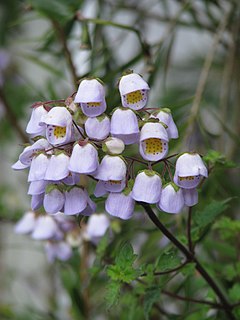
Jovellana violacea, also known as the violet teacup flower or violet slipper flower, is a perennial species of flowering plant in the family Calceolariaceae. It is native to Chile.





















